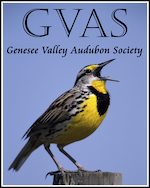Some Things to Know About Egg Laying
I was all set to write an article about the behavioral changes we’d see as Mariah prepares to lay her eggs, but she skunked me, and laid her first egg before I was ready! That’s a lesson for us all– when watching these falcons, expect the unexpected.
Now that she’s laid her first egg, let’s talk about what we can expect from Mariah over the coming days. Since Kaver arrived on the scene in 2002 Mariah has never laid fewer than four eggs. In 2003, 2004 & 2005, Mariah laid five eggs and all fifteen of those eyases (the name for falcon chicks) survived to fledge– that is, to take their first flights. That was a record in New York State.
Last year Mariah laid 6 eggs! She suffered an injury to one of her legs right around the time they began hatching, and her reduced movement hindered her ability to care for the eggs and her new chicks. As a result, only three eyases survived, but all of them went on to be remarkable fliers.

Mariah with eggs in 2002
How many eggs can we expect this year? It’s always hard to say, but if the past years are any indication, it should be at least four. We’ll know for sure in a few more days. Peregrines lay an egg about every two days. Mariah takes things a little slower than the average Peregrine, laying an egg every 53 hours, give or take an hour or two.
Between eggs, her behavior is that of an expectant mom– she’s lethargic, and she’ll spend a lot of time near the nest, if not actually inside the nest box. She may also have a fluffed-up appearance, or even look unkempt, with her feathers all askew. It’s the Peregrine equivalent of a bad hair day. As the picture at the left shows, she may also look heavy, or gravid as the eggs form inside her.
Once fertilization occurs the egg begins moving down her oviduct. It’s sort of on an assembly line where the egg gets built, layer by layer. First comes several coatings of yolk. The egg moves a little farther down the ovidicut where it gets covered with albumen (the clear fluid that we’d call egg white) and various membranes. Then it continues on its way until shortly before she’s ready to lay the egg, it gets its final layer, the shell. The whole process takes a little more than a day.
The actual act of laying the eggs can take as little as a few minutes or as long as an hour or more. When she’s ready to lay her egg, Mariah will sit in the scrape. She may look like she’s sleeping, or at least taking a nap, but if you watch carefully, you’ll notice that she starts to move around as the egg is laid. She typically keeps the egg covered after it’s laid for 10 to 20 minutes before moving off the nest and letting us have a good look.
Peregrine eggs are speckled, and vary in color from light pink to darker brown or purple. Older falcons may produce lighter colored eggs. Each one is about the size of a small chicken egg.
One bit of behavior that many people find unusual is that she won’t begin incubating the eggs, or brooding, right away. Believe it or not, that’s perfectly normal for Peregrines. She’ll begin brooding when the next to last egg is laid, so when she starts, we can be pretty sure we know how many eggs she’ll lay– just add one to the current number. Before then, she’ll mostly leave the eggs uncovered. Don’t worry though– Peregrine eggs can survive just fine unless the temperature drops below freezing. If that happens, she’ll sit on the eggs just to keep them warm enough to stay viable. We’ll talk more about brooding and incubation soon. In the meantime, keep watching!
-Jess





March 27th, 2007 at 2:21 PM
Thank you ,Jess for the explanation as to our Mama not yet sitting on her egg. I was just about to jot a note about it. She, and of course Kav, are no less awesome than when I first watched them. I get so excited and I so love everyone’s comments! Thank you all!
March 27th, 2007 at 3:52 PM
I love the falcon cam!!! How long will it take for the eggs to hatch?
March 27th, 2007 at 4:00 PM
Thanks so much for doing this! This is my fourth or fifth year watching these two. We are watching closely in Kabletown, WV. Can’t wait to see how many they will have this year.
March 27th, 2007 at 7:24 PM
Lots of great information here Jess.
March 27th, 2007 at 9:37 PM
Jess, thanks for your clear writing.
I’m no eggspert, but I have kept other birds (chickens). When the hen lays an egg, she will stand over the egg for about 10 minutes,so the wet egg can dry off (the wetness contains bacteriocidal “stuff” that helps keep the embryo sterile as it develops in eggo).
Chickens who don’t have their eggs collected every day will also wait until they have laid a bunch of eggs before they start brooding. That way, all the eggs hatch at about the same time, resulting in a little less work for the hen. She is, once again, free to move about the yard.
March 27th, 2007 at 10:32 PM
Jess … A huge thank you for your expertise!! And explaining in terms anyone can understand.
March 28th, 2007 at 8:46 AM
Jess,
Are there any studies on the offspring? Are they imprinted on the Rochester area,and if so, have any returned and established their own families?
Thank you,
George and Donna
March 28th, 2007 at 10:12 AM
Your journal is very impressive. I have followed the old ‘birdcam’ site for years and have never seen some of the information you provide. Keep up the good work and thanks!
March 28th, 2007 at 11:00 AM
@Nicky- We’ll be discussing incubation times in our next article, so keep reading!
@George- We only know the fates of a few of Mariah’s offspring. We’ll be publishing a comprehensive history of the Rochester Falcons in the next couple of months. In the meantime, you can view pictures of Freedom (one of Mariah’s offspring from 2002) and his family in this Kodak EasyShare Gallery album.
@Beth- We’re glad to report that Mariah’s leg injury appears to have fully healed. She is moving normally, bearing full weight on the leg and using it to grasp prey, so we’re confident that she has recuperated.
March 28th, 2007 at 11:03 AM
[…] wondered if she wasn’t laying a new one, but alas, no new eggs today. At least not so far […]
April 5th, 2007 at 10:56 AM
Control Corporation in Bloomington, Mn., had a pair of Peregrine Falcons to dispel the pigeons rapidly multiplying around our Tower. The Falcons were very successful in their quest of food and hatched a brood every year. One year a new chick was lost tumbling down to his/her death while learning to fly for the first time! We employees had already named the newborn and grieved on behalf of the parents . They circled for a long time and their cries were plaintive.
I could walk directly up to the window with the Peregrine Falcons perched on the outside ledge and I on the inside and they weren’t frightened. That was always a thrill for me to be that close! They are indeed majestic!!!
April 17th, 2007 at 8:59 AM
jess,
thank you for a great site – keep up the good work !
April 27th, 2010 at 9:44 AM
[…] at some of the pictures makes it clear that this one did have a yolk inside. We’ve discussed egg laying, along with the falcon reproductive cycle in previous Imprints articles (click the links to view […]